A Novel Minimally Invasive Surgical Procedure for the Treatment of Steatocystoma Multiplex
Abstract
Background: Steatocystoma multiplex (SM) is an asymptomatic benign skin lesion, characterized by multiple sebum-containing dermal cysts.
Objectives: In this study, we report a novel surgical procedure of removal of the cysts followed by a 5-fluorouracil injection to fulfill the cosmetic needs of patients with SM.
Methods: From January 2023 to January 2024, 35 patients with SM, 2 of whom showed septic steatocystoma, were surgically treated with the novel surgical method in the First Affiliated Hospital of Xi’an Jiaotong University. All procedures were performed in the outpatient operating room. Patients were in close follow-up for postoperative data, with the most recent follow-up until March 2024.
Results: The surgical intervention is completed within a maximum duration of 40 min for each patient, and all 35 patients with SM exhibited complete postoperative wound healing with no relapse, no cicatrization, and limited hyperpigmentation in mere 4 patients (all within 3 months postoperatively), indicating a favorable overall cosmetic outcome at the latest follow-up in March 2024.
Conclusion: Surgical removal of the cysts with subsequent 5-fluorouracil injection is a promising and novel operative procedure for SM which is minimally invasive, fulfills the cosmetic needs of the patients, and leads to no recurrence in any case.
1. Introduction
Steatocystoma multiplex (SM) is a benign lesion of the sebaceous glands that arises from sebaceous follicles and presents as widespread asymptomatic skin cysts, typically skin-colored or yellowish-brown in appearance [1–3]. SM is primarily concentrated in regions with abundant sebaceous glands, commonly found on the trunk, limbs, and scalp [2, 4]. As the majority of these lesions are asymptomatic and do not pose an increased risk of malignancy, patients typically seek medical intervention for cosmetic reasons [3, 5–7]. In addition, submucosal surgery is associated with an increased risk of infection and suppuration, which can lead to cicatrization and patient dissatisfaction [2, 8, 9]. This study presents a novel surgical technique that combines cyst removal with subsequent 5-fluorouracil injection for SM to reduce the likelihood of SM recurrence and shorten the duration of treatment. The study analyzed as treated with this procedure and monitored their outcome.
2. Materials and Methods
In the management of SM, we have developed a new surgical procedure that combines traditional surgical resection with modified methods and 5-fluorouracil injection. After local anesthesia, we made a puncture with an 18-gauge needle at the site of the steatocystoma, forming a fine 1 mm pinhole through which the sebum, hair, and other contents could be extracted under compression. Through the fine pinhole, single-toothed forceps were then inserted into the cyst cavity for repeated probing, and the thumb and forefinger were used to repeatedly press around the cyst to facilitate the discharge of the cyst contents, and vascular forceps were used to assist in the removal the cyst contents. Afterward, the cyst wall is extracted with single-tooth forceps, and the entire cyst wall is grasped out with vascular forceps to minimize the possibility of recurrence [10]. For the cyst wall that fails to be clamped out completely, repeated insertions with single-tooth forceps are performed to destroy the maximum portion of the cyst wall [11–13]. Eventually, 5-fluorouracil is injected into the site of the previous cyst to provide local chemotherapy to the potential residual cyst wall to reduce the possibility of recurrence. The injection should be made by mixing 5FU with 4 times the volume of saline, inserting the needle at a 45° angle of inclination, and injecting 0.1–0.2 mL of the 5FU mixture into the site of the previous cyst. As the cyst has been disrupted at this point, the drug is likely to flow out to help flush the wound and can be wiped clean using a gauze. Postoperatively, Chlorhexidine-iodophor(CHX-IP) composite solution was used to sterilize the operation area, and then tissue adhesive (EPIGLU, Meyer-Haake) was used for the closure of the needle puncture [14]. With this method, the length of the incision can be reduced to 1 mm, which accelerates healing, and reduces the risk of infection, with no patient feedback to leave a scar and recurrence.
3. Case Report
From January 2023 to January 2024, a total of 35 SM patients underwent cyst removal followed by 5-fluorouracil injections in the outpatient surgical facility of the Department of Dermatology, First Affiliated Hospital of Xi’an Jiaotong University. In this study, pathological information, surgical status, and other relevant data were recorded and followed up until March 2024. The data analyzed and reported in this study did not contain any personally identifiable information, so informed consent was waived.
Of the 35 patients diagnosed with SM, 13 were male and 22 were female, with a median age of 26.2 years. Two male patients presented with septic infections. Each patient had more than 30 steatocystomas located on the trunk, neck, and extremities. Cyst excision followed by a 5-fluorouracil injection procedure allowed for the removal of each steatocystoma in less than 1 minute, and each patient was treated in not more than 40 min. No systemic antibiotics were given postoperatively. All 35 patients with SM showed complete closure of the pinhole after surgery, with no recurrence or cicatrization, and only a mild hyperpigmentation in 4 patients (all less than 3 months after surgery) at the last follow-up in March 2024, indicating an overall favorable cosmetic outcome.
Here, we describe in detail the treatment of one of these SM patients who underwent the cyst excision followed by 5-fluorouracil.
The patient with SM, a 26-year-old male, presented with skin-colored papules or nodules on the chest, abdomen, and lumbar spine, along with a massive, presumably infected cyst on the abdomen (Figure 1). The cyst contained a grayish-black putrefactive material, which was thoroughly cleaned and irrigated at the time of treatment (Figure 2). The follow-up of the patient in March 2024, only one month after surgery, showed complete closure of the pinhole, with no cicatrix and only limited hyperpigmentation (Figure 3). No recurrence was observed in the surgical area.
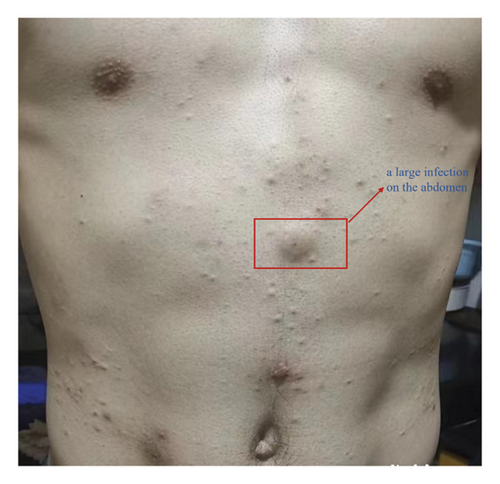
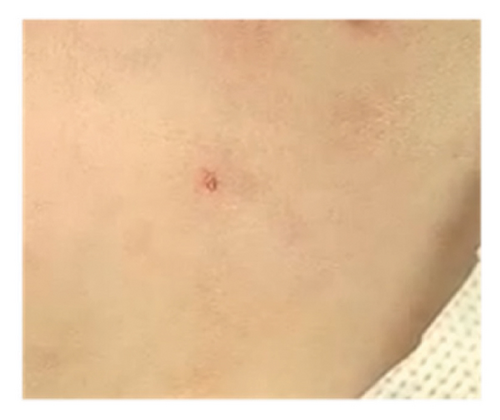
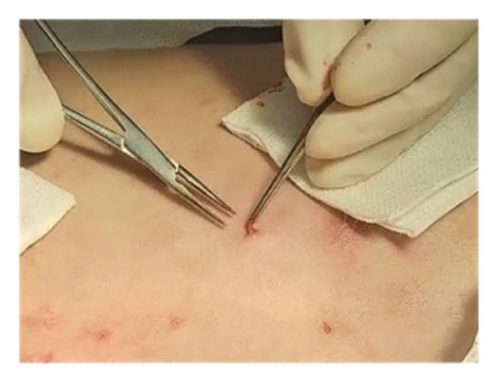
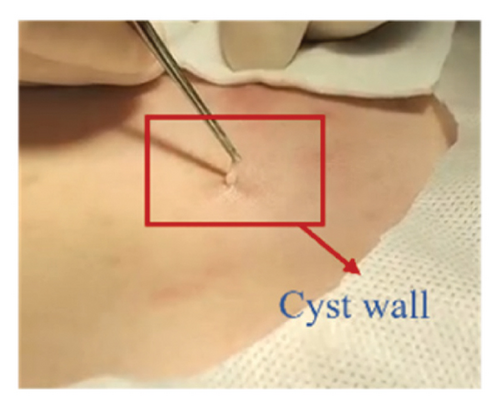
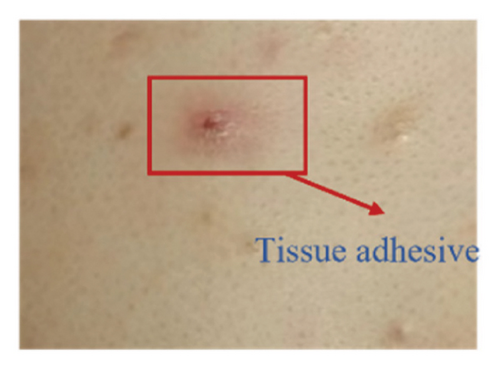
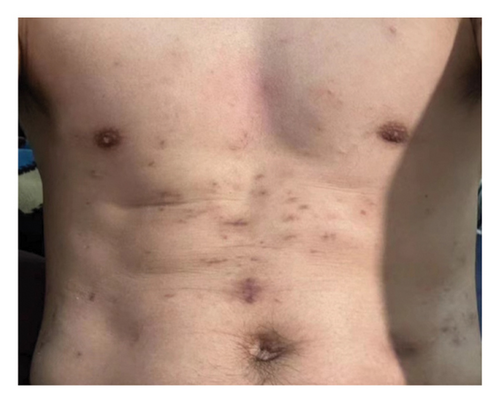
4. Discussion
Due to the generally benign nature of SM, patients typically pursue management primarily for esthetic reasons, and cases of septic steatocystoma are rather uncommon [5]. Besides, minimally invasive surgical procedures have become increasingly popular, as have postoperative cosmetic outcomes [10, 14]. The management of SM includes carbon dioxide laser ablation, cryotherapy, and surgical resection [5, 7, 10, 15–19]. However, carbon dioxide laser ablation is not suitable for larger lesions [7, 16, 20], while cryotherapy is less effective [18, 21]. While surgical excision could completely remove SM, traditional incisions made with scalpels had a more extensive incision area, leading to a higher probability of subsequent cicatrization and hyperpigmentation [10, 15]. As a result, surgical resection is associated with esthetic compromise, making it a less-than-ideal option for asymptomatic SM patients [3]. In summary, there is currently a conflicting evidence regarding surgical treatments for SM and a consensus has not been reached.
Modified surgical techniques have been proposed to address the need for minimal incision. Kanee was the first to describe a technique for the excision of sebaceous cysts utilizing electrocoagulation and forceps [22], laying the foundation for today’s minimally invasive surgical options, which have gradually been improved and applied to the treatment of SM in recent years. Jiang et al. [14] proposed a modified surgical method to remove the cyst walls using single-toothed forceps, but in practice, it is often reported that the cyst walls are unable to be easily removed, resulting in a leakage during surgery [19]. Prolonged treatment during surgery and the high technical demands on the surgeon often lead to leakage in the patients with large cysts. Therefore, we believe that simply destroying the cyst wall with forceps is not sufficient due to the high risk of recurrence.
Regarding the modified surgical procedure proposed so far, the cyst removal ensures a postoperative cosmetic result, but the cyst contents are not completely removed in most cases and are susceptible to infection and recurrence [19, 23]. The effectiveness of removing the cyst wall with single-tooth forceps is limited by the skill of the surgeon and the time available for treatment. The destruction of the cystic wall with a curette only leaves the cystic wall still in place, and there is also a substantial risk of recurrence [23, 24]. Therefore, we advocate for the removal of as much of the cyst wall as feasible [24].
In addition, the use of 5-fluorouracil is also worth mentioning. Given the propensity for recurrence associated with SM, the inadvertent retention of a small portion of the cyst wall during surgical excision may lead to recurrence complications for the patient. In this case, local chemotherapy utilizing 5-fluorouracil may be employed to mitigate the risk of recurrence [11–13]. The findings indicate that cyst removal with subsequent 5-fluorouracil injection can be used for the thorough removal of the cyst contents. However, during the treatment process, it should be recognized that 5-fluorouracil may cause discomfort to the patient, and it is necessary to have active communication with the patient to eventually decide whether to use 5-fluorouracil. Due to the limited number of patients diagnosed with SM, we have encountered a scarcity of individuals willing to undergo treatment at our institution. Therefore, we can only report on current treatment experience, and it is difficult to conduct randomized controlled trials to more accurately evaluate the benefits of 5-fluorouracil in the treatment of SM. Meanwhile, the limitations, side effects, and potential systemic absorption of 5-fluorouracil will also be discussed in the subsequent period. Due to the limitation of the number of cases, we will further validate the benefits of our approach in a larger cohort under conditions with a larger number of cases in the follow-up.
We suggest that cysts’r emoval with subsequent 5-fluorouracil injection could remove large areas of SM in a short time, with the advantages of small pinholes, rapid closure, almost no infection encountered, lower risk of recurrence, and a further reduction of the possibility of scarring and hyperpigmentation.
In conclusion, our report presents an analysis of 35 cases and introduces an innovative surgical intervention involving cyst excision followed by the administration of 5-fluorouracil for the management of SM, highlighting the advantages of this approach over published surgical techniques. We suggest that this approach should be promoted to contribute to the minimally invasive treatment and meet the cosmetic needs of SM patients.
Conflicts of Interest
The authors declare no conflicts of interest.
Author Contributions
Nan Zhang and Zepeng Li contributed equally to this work.
Funding
No funding was received to assist with this research.
Open Research
Data Availability Statement
The original research data of this study are from the Department of Dermatology, the First Affiliated Hospital of Xi’an Jiaotong University, and all experimental results or data used to support relevant conclusions are included in the manuscript. Due to departmental policies and the needs of subsequent research by the research team, the specific data generated in this study cannot be made public. If necessary, the corresponding author can be contacted for consultation after stating the needs.




